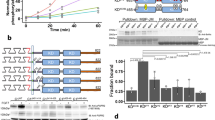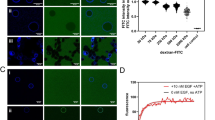Abstract
Local stimulation with epidermal growth factor can induce lateral propagation of epidermal-growth-factor-receptor phosphorylation at the plasma membrane. We discuss mechanisms of phosphorylation propagation and its possible function. Is it the spatial transmission of a local stimulus or is it an aspect of a feedback-signalling-reaction network that generates a switch response to growth-factor stimulation?
This is a preview of subscription content, access via your institution
Access options
Subscribe to this journal
Receive 12 print issues and online access
$189.00 per year
only $15.75 per issue
Buy this article
- Purchase on Springer Link
- Instant access to full article PDF
Prices may be subject to local taxes which are calculated during checkout



Similar content being viewed by others
References
Verveer, P. J., Wouters, F. S., Reynolds, A. R. & Bastiaens, P. I. H. Quantitative imaging of lateral ErbB1 receptor signal propagation in the plasma membrane. Science 290, 1567–1570 (2000).
Sawano, A., Takayama, S., Matsuda, M. & Miyawaki, A. Lateral propagation of EGF signalling after local stimulation is dependent on receptor density. Dev. Cell 3, 245–257 (2002).
Hubbard, S. R., Mohammadi, M. & Schlessinger, J. Autoregulatory mechanisms in protein tyrosine kinases. J. Biol. Chem. 273, 11987–11990 (1998).
Sundaresan, M., Yu, Z. X., Ferrans, V. J., Irani, K. & Finkel, T. Requirement for generation of H2O2 for platelet-derived growth factor signal transduction. Science 270, 296–299 (1995).
Mahadev, K., Zilbering, A., Zhu, L. & Goldstein, B. J. Insulin-stimulated hydrogen peroxide reversibly inhibits protein-tyrosine phosphatase 1b in vivo and enhances the early insulin action cascade. J. Biol. Chem. 276, 21938–21942 (2001).
Bae, Y. S. et al. Epidermal growth factor (EGF)-induced generation of hydrogen peroxide. Role in EGF receptor-mediated tyrosine phosphorylation. J. Biol. Chem. 272, 217–221 (1997).
Finkel, T. Oxygen radicals and signaling. Curr. Opin. Cell Biol. 10, 248–253 (1998).
Meng, T. C., Fukada, T. & Tonks, N. K. Reversible oxidation and inactivation of protein tyrosine phosphatases in vivo. Mol. Cell 9, 387–399 (2002).
Denu, J. M. & Tanner, K. G. Specific and reversible inactivation of protein tyrosine phosphatases by hydrogen peroxide: evidence for a sulfenic acid intermediate and implications for redox regulation. Biochemistry 37, 5633–5642 (1998).
Ostman, A. & Bohmer, D. Regulation of receptor tyrosine kinase signaling by protein tyrosine phosphatases. Trends Cell Biol. 11, 258–266 (2001).
Reynolds, A., Tischer, C., Verveer, P. J., Rocks, O. & Bastiaens, P. I. H. Epidermal growth factor receptor activation coupled to inhibition of protein tyrosine phosphatases causes lateral signal propagation. Nature Cell Biol. 5, 447–453 (2003).
Stamos, J., Sliwkowski, M. X. & Eigenbrot, C. Structure of the epidermal growth factor receptor kinase domain alone and in complex with a 4-anilinoquinazoline inhibitor. J. Biol. Chem. 277, 46265–46272 (2002).
Thannickal, V. J. & Fanburg, B. L. Reactive oxygen species in cell signalling. Am. J. Physiol. Lung Cell Mol. Physiol. 279, 1005–1028 (2000).
Schlessinger, J. Cell signaling by receptor tyrosine kinases. Cell 103, 211–225 (2000).
Bertics, P. J. & Gill, G. N. Self-phosphorylation enhances the protein-tyrosine kinase activity of the epidermal growth factor receptor. J. Biol. Chem. 260, 14642–14647 (1985).
Hsu, C. Y., Hurwitz, D. R., Mervic, M. & Zilberstein, A. Autophosphorylation of the intracellular domain of the epidermal growth factor receptor results in different effects on its tyrosine kinase activity with various peptide substrates. Phosphorylation of peptides representing Tyr(P) sites of phospholipase C-γ. J. Biol. Chem. 266, 603–608 (1991).
Gotoh, N., Tojo, A., Hino, M., Yazaki, Y. & Shibuya, M. A highly conserved tyrosine residue at codon 845 within the kinase domain is not required for the transforming activity of human epidermal growth factor receptor. Biochem. Biophys. Res. Commun. 186, 768–774 (1992).
Ferrell, J. E. Self-perpetuating states in signal transduction: positive feedback, double-negative feedback and bistability. Curr. Opin. Cell Biol. 14, 140–148 (2002).
Ferrell, J. E. & Xiong, W. Bistability in cell signaling: How to make continuous processes discontinuous and reversible processes irreversible. Chaos 11, 227–236 (2001).
Tyson, J. J., Chen, K. C. & Novak, B. Sniffers, buzzers, toggels and blinkers: dynamics of regulatory and signaling pathways in the cell. Curr. Opin. Cell Biol. 15, 221–231 (2003).
Macinnis, B. L. & Campenot, R. B. Retrograde support of neuronal survival without retrograde transport of nerve growth factor. Science 295, 1536–1539 (2002).
Senger, D. L. & Campenot, R. B. Rapid retrograde tyrosine phosphorylation of trkA and other proteins in rat sympathetic neurons in compartmented cultures. J. Cell Biol. 138, 411–421 (1997).
Yarden, Y. & Sliwkowski, M. X. Untangling the ErbB signalling network. Nature Rev. Mol. Cell Biol. 2, 127–137 (2001).
Einstein, A. On the movement of small particles suspended in a stationary liquid demanded by the molecular-kinetic theory of heat. Ann. Phys. 17, 549–560 (1905).
Murray, J. D. Mathematical Biology (Springer Verlag, Berlin, 1993).
Author information
Authors and Affiliations
Related links
Rights and permissions
About this article
Cite this article
Tischer, C., Bastiaens, P. Lateral phosphorylation propagation: an aspect of feedback signalling?. Nat Rev Mol Cell Biol 4, 971–975 (2003). https://doi.org/10.1038/nrm1258
Issue Date:
DOI: https://doi.org/10.1038/nrm1258
This article is cited by
-
A conformational sensor based on genetic code expansion reveals an autocatalytic component in EGFR activation
Nature Communications (2018)
-
Ubiquitination switches EphA2 vesicular traffic from a continuous safeguard to a finite signalling mode
Nature Communications (2015)
-
Spatial organization of intracellular communication: insights from imaging
Nature Reviews Molecular Cell Biology (2010)
-
Quantitative microscopy and systems biology: seeing the whole picture
Histochemistry and Cell Biology (2008)
-
Cell-signalling dynamics in time and space
Nature Reviews Molecular Cell Biology (2006)



